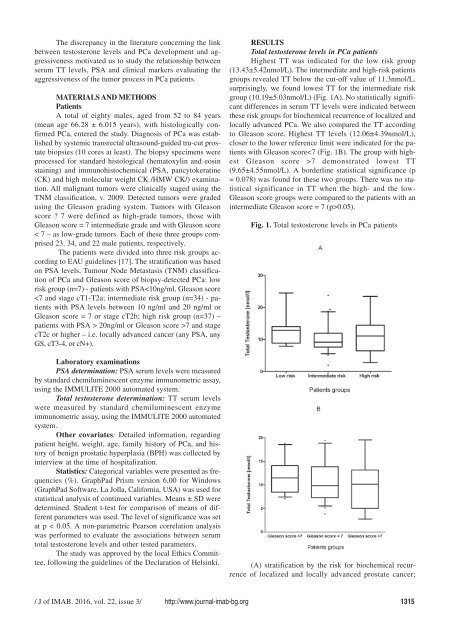JofIMAB-2016-vol22-issue3
Create successful ePaper yourself
Turn your PDF publications into a flip-book with our unique Google optimized e-Paper software.
The discrepancy in the literature concerning the link<br />
between testosterone levels and PCa development and aggressiveness<br />
motivated us to study the relationship between<br />
serum TT levels, PSA and clinical markers evaluating the<br />
aggressiveness of the tumor process in PCa patients.<br />
MATERIALS AND METHODS<br />
Patients<br />
A total of eighty males, aged from 52 to 84 years<br />
(mean age 66.28 ± 6.015 years), with histologically confirmed<br />
PCa, entered the study. Diagnosis of PCa was established<br />
by systemic transrectal ultrasound-guided tru-cut prostate<br />
biopsies (10 cores at least). The biopsy specimens were<br />
processed for standard histological (hematoxylin and eosin<br />
staining) and immunohistochemical (PSA, pancytokeratine<br />
(CK) and high molecular weight CK /HMW CK/) examination.<br />
All malignant tumors were clinically staged using the<br />
TNM classification, v. 2009. Detected tumors were graded<br />
using the Gleason grading system. Tumors with Gleason<br />
score ? 7 were defined as high-grade tumors, those with<br />
Gleason score = 7 intermediate grade and with Gleason score<br />
< 7 – as low-grade tumors. Each of these three groups comprised<br />
23, 34, and 22 male patients, respectively.<br />
The patients were divided into three risk groups according<br />
to EAU guidelines [17]. The stratification was based<br />
on PSA levels, Tumour Node Metastasis (TNM) classification<br />
of PCa and Gleason score of biopsy-detected PCa: low<br />
risk group (n=7) - patients with PSA7 and stage<br />
cT2c or higher – i.e. locally advanced cancer (any PSA, any<br />
GS, cT3-4, or cN+).<br />
Laboratory examinations<br />
PSA determination: PSA serum levels were measured<br />
by standard chemiluminescent enzyme immunometric assay,<br />
using the IMMULITE 2000 automated system.<br />
Total testosterone determination: TT serum levels<br />
were measured by standard chemiluminescent enzyme<br />
immunometric assay, using the IMMULITE 2000 automated<br />
system.<br />
Other covariates: Detailed information, regarding<br />
patient height, weight, age, family history of PCa, and history<br />
of benign prostatic hyperplasia (BPH) was collected by<br />
interview at the time of hospitalization.<br />
Statistics: Categorical variables were presented as frequencies<br />
(%). GraphPad Prism version 6.00 for Windows<br />
(GraphPad Software, La Jolla, California, USA) was used for<br />
statistical analysis of continued variables. Means ± SD were<br />
determined. Student t-test for comparison of means of different<br />
parameters was used. The level of significance was set<br />
at p < 0.05. A non-parametric Pearson correlation analysis<br />
was performed to evaluate the associations between serum<br />
total testosterone levels and other tested parameters.<br />
The study was approved by the local Ethics Committee,<br />
following the guidelines of the Declaration of Helsinki.<br />
RESULTS<br />
Total testosterone levels in PCa patients<br />
Highest TT was indicated for the low risk group<br />
(13.43±5.42nmol/L). The intermediate and high-risk patients<br />
groups revealed TT below the cut-off value of 11.3nmol/L.<br />
surprisingly, we found lowest TT for the intermediate risk<br />
group (10.19±5.03nmol/L) (Fig. 1A). No statistically significant<br />
differences in serum TT levels were indicated between<br />
these risk groups for biochemical recurrence of localized and<br />
locally advanced PCa. We also compared the TT according<br />
to Gleason score. Highest TT levels (12.06±4.39nmol/L),<br />
closer to the lower reference limit were indicated for the patients<br />
with Gleason score7 demonstrated lowest TT<br />
(9.65±4.55nmol/L). A borderline statistical significance (p<br />
= 0.078) was found for these two groups. There was no statistical<br />
significance in TT when the high- and the low-<br />
Gleason score groups were compared to the patients with an<br />
intermediate Gleason score = 7 (p>0.05).<br />
Fig. 1. Total testosterone levels in PCa patients<br />
(A) stratification by the risk for biochemical recurrence<br />
of localized and locally advanced prostate cancer;<br />
/ J of IMAB. <strong>2016</strong>, vol. 22, issue 3/ http://www.journal-imab-bg.org 1315



